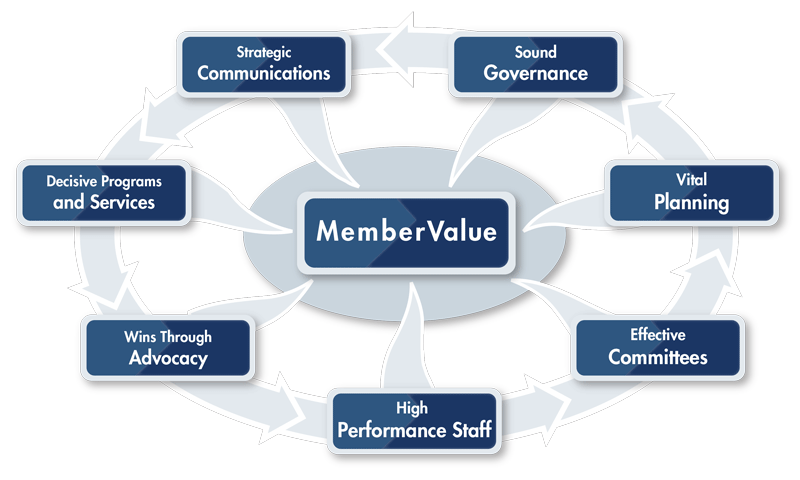In the past two decades, I have been privileged to work with the leadership of many Canadian professional and trade associations. Each engagement has been a window into what works and what doesn’t, in terms of creating and sustaining value for members.
We have identified seven areas that each association should master.

The first four areas simply create the capacity to serve our members. The final three areas (strategic communications, programs and services, and wins through advocacy) provide the real value to members.
Below, I have defined each area and provided some personal perspectives.
Sound Governance involves strengthening the governing structures including membership classes, bylaws, operating policies and the annual governance cycle. The governance system should enable stronger decision-making and reduce frustrations.
A perspective – I would counsel against addressing governance changes without very good reasons. Making changes in this area is a lot like doing renovations in the home. They take up a lot of resources and may paralyze other activities for a period of time. Consequently, I think that a governance review is something to be contemplated once every five years or more.
Vital Planning includes setting the strategic direction with a multi-year strategic plan, along with annual work plans and a capital and operating budget.
A perspective – My definition of an ideal planning system is “one that is not time-consuming, aids job performance and drives organizational success”. In terms of the time taken to conduct planning, strategic planning should consume no more than three days a year, averaged over the life of the plan. Work planning should be less. So should the budgeting process. The strategic plan should have clearly defined outcomes, that are both measurable and time framed. The work plans should be template forms – not long narrative documents. The budget needs to be aligned to the other two plans.
Effective Committees – means having a standard approach to establishing, conducting and winding up committees.
A perspective – This is an area that can make a huge difference in both member satisfaction and in achieving overall results. Creating an association committee handbook, providing staff training and holding Chairs’ orientation sessions, are integral parts of an effective committee system.
High Performance Staff – means having the technical capacity to run the organization. It should include clarity around roles and responsibilities and ongoing professional development.
A perspective – If you don’t have a performance management system, get one. Make sure it is linked to the strategic plan and work plans. Association staff can be vulnerable to the whims of a voluntary Board, so make sure that staff performance is assessed using objective data; ones your strategic and operational plans provide.
Strategic Communications potentially requires a focus on three audiences: the members, in order to get greater buy in; stakeholders, to generate more awareness and support for the association’s priorities; and the general public, to increase support for members’ interests.
A Perspective – Unless you work in one of the few associations that have substantial sources of revenue, trying to move the needle on public perception is almost impossible. Therefore, most associations have only two audiences.
Most association staff overestimate what their members know. Members too often underestimate what their association is doing for them. Build a sustainable system of communications to members with technology that works. Provide amounts of information that are digestible and at the right frequency.
Strategic Framework Program for Associations
Decisive Programs and Services – is about creating and delivering programs and services that provide value to members.
A perspective – First, each existing program or service should be treated as discrete business units, which means they must be financially sustainable. Second, programs and services must truly meet member needs. Do the programs undertake jobs that members would otherwise be doing? Are the current or potential programs reducing member pains and/or increasing member gains? Have members explicitly agreed that each of these questions can be answered affirmatively? If not, the programs or services may be defying business gravity and could come to ground.
Wins through Advocacy – involves a threefold set of activities:
- Defining the challenges facing our sector/profession
- Triaging our priorities; and
- Developing and implementing advocacy strategies.
At the end of the day it is about wins for our members.
A perspective – Too often the advocacy function in associations resembles a scattergun approach. If associations get in to see a senior bureaucratic official or political minister, it is easy to visualize officials or ministers seemingly thanking them for presenting their “five number one priorities”. If the industry or profession can’t triage and can’t prioritize, why should the opposite party do it for them?
Finally, any advocacy approach should incorporate a well-developed narrative story that helps different audiences understand the importance of the industry or profession. It should describe how a series of win-win decisions could be beneficial to a range of interests. Advocacy should be about helping the right decision-makers come to the right decisions.
In Summary
Build the capacity to do great work for members by ensuring sound governance, doing the vital planning, operating effective committees and having a high performing staff.
Deliver the value to your members with strategic communications, decisive programs and services, and wins for your members through advocacy.

